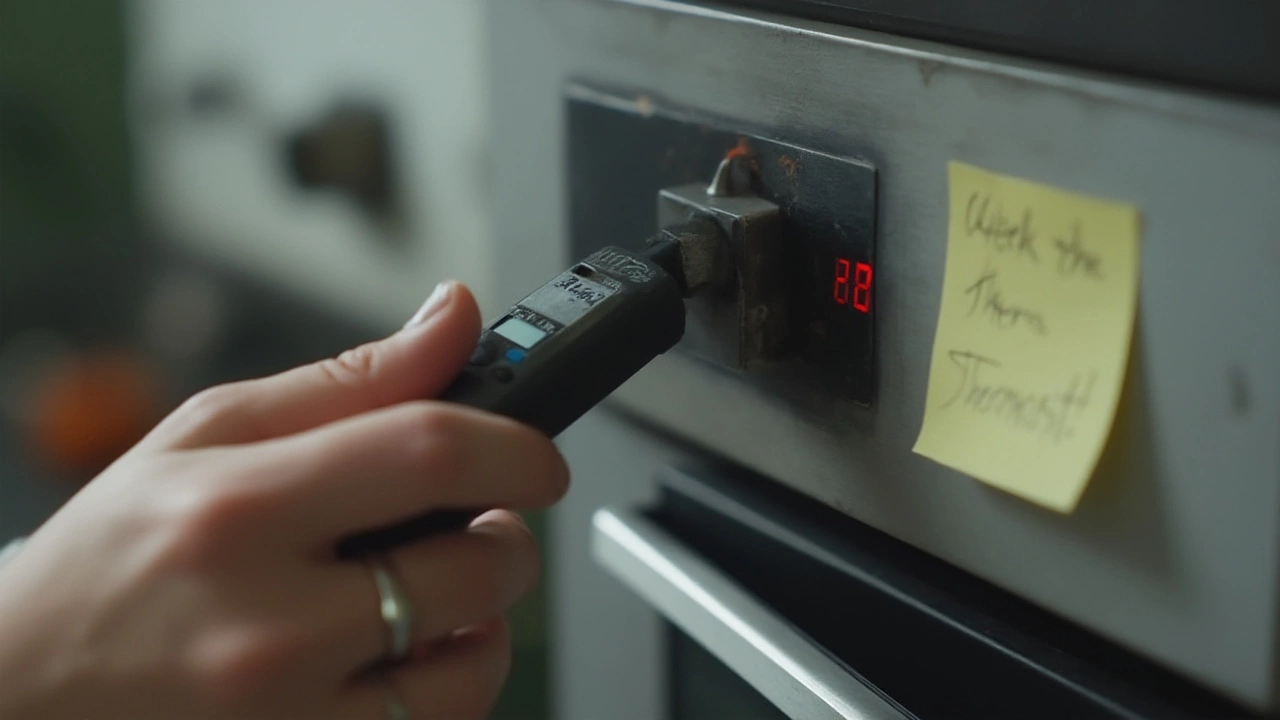Picture this: you’re ready to bake your famous chocolate chip cookies, you slide the tray into the oven, set the temp, and... nothing happens. Or maybe your Sunday roast turns out cold in the middle and charred on the outside. When your oven throws tantrums like these, either the element or the thermostat is usually at fault. But how can you tell which one’s the real culprit?
If you’re tired of unevenly cooked food or an oven that’s just plain dead, you’re not alone. Figuring out if the oven element or the thermostat is broken isn’t rocket science. With a bit of basic know-how, you can save yourself some cash and hassle—and avoid that panicked call to the repairman over something simple.
Understanding How Your Oven Cooks
Most home ovens rely on two big parts to actually cook your food: the heating element (sometimes called the bake or grill element) and the thermostat. The heating element is the metal bar—usually at the top, bottom, or both—that glows red-hot to produce heat. When you dial up a temperature, the element cranks up and turns your oven into a mini furnace.
The thermostat, for its part, is the little brain behind the operation. This sensor reads the temperature inside your oven and tells the element when to turn on or off to keep things consistent. If your setpoint is 180°C, the thermostat tries to keep it around that range, toggling the element as needed.
Most modern electric ovens in New Zealand, including wall ovens and freestanding ranges, share this basic setup. Gas ovens work a bit differently, but even they rely on a thermostat to regulate that blue flame. A broken element or thermostat knocks your whole baking game out of whack—baking enthusiasts in Auckland know this headache all too well.
Here’s a wild stat: according to appliance repair techs here, about 80% of oven issues in Kiwi homes come down to either faulty elements or dodgy thermostats. Luckily, there’s usually a clear way to test which one needs fixing.
Signs Your Oven Element Is Broken
The oven element is the usual suspect if you’re suddenly getting cold dinners or oven-cooked meals that take way longer than the recipe says. But not all symptoms are obvious. Watch for these classic signs:
- No heat at all – You set your oven to bake, wait for the preheat beep, but it stays stone cold even after ages. The fan might still run and lights may work, but there’s no warmth.
- Uneven cooking – Only one side of your lasagna browns, or you notice raw patches on baked goods. Sometimes half the element will go bad and the rest struggles to keep up.
- Visible damage – Turn off the power and peek inside. If you see cracks, blisters, or breaks in the element (that U-shaped metal bar), it’s likely fried.
- Sparks or smoke – Sometimes a break in the element causes sparking, smoking, or even a mild burning smell. Don’t ignore this; it’s a fire risk and should be switched off at the wall.
- Oven trips the breaker – Faulty elements can short out and trip the main fuse, especially common in older Auckland homes with sensitive switchboards.
The element responds directly to your oven’s temperature controls. If it’s gone, the oven can’t produce heat, no matter what you do. Pro tip: slide your hand (carefully) near the element when the oven’s supposed to be hot. If it’s not radiating heat or glowing at all, you’ve probably found your problem.
Clues Your Oven Thermostat Has Failed
A broken thermostat is trickier to catch, because your oven might still produce heat—it just won’t get the temperature right. This leads to all sorts of frustrating kitchen dramas. Here’s what to keep an eye out for:
- Food burns or undercooks no matter the setting – You follow recipes to the letter, but cakes collapse, and roasts are raw in the middle. If your oven says 180°C but operates wildly above or below, the thermostat could be to blame.
- Strange cycling – The oven heats up, then switches off too soon, or refuses to stop heating. This inconsistency ruins even the simplest recipes.
- Discrepancy between set and actual temperature – Stick an oven thermometer inside and compare. If your setting says 200°C but the actual temp’s way off even after waiting 20 minutes, suspect the thermostat.
- Oven stays on – Some thermostats stick, and the oven never knows when to stop heating. You’ll notice this when food gets scorched, or the oven is worryingly hot to the touch.
- No click or indicator light – Older ovens with a mechanical thermostat let you hear a faint click as the element comes on or off. If you no longer hear it—or the neon “heating” light never cycles—your thermostat may be stuck or dead.
One Auckland baker I know went through three burnt cheesecakes before realizing her beloved 90s Westinghouse wasn’t holding temperature due to a tired-out thermostat. If you’re finding it impossible to get consistent results—especially after ruling out user error—it’s time to investigate.

How to Test Your Oven Element and Thermostat
Time for a little detective work. Don’t worry, you don’t need fancy tools or a degree in electrical engineering. Here’s how to figure out what’s gone wrong before you call for backup:
- Visual inspection – Always turn off the oven (unplug it if possible) and let it cool down. Use a torch to check the element for any visible breaks, bubbles, or burn marks.
- Check for heat – Set the oven to bake at its max temp. After five minutes, carefully feel near (not on!) the element—if it’s cold, it’s probably dead.
- Oven thermometer test – Set a separate oven thermometer inside, then preheat to 180°C. After 20 minutes, check the reading. Too high or low means the thermostat’s lying to you.
- Element continuity test (if you’re handy) – With power off, use a multimeter to test for continuity on the element’s terminals. No reading means the element is kaput. There are heaps of step-by-step guides for this on YouTube, or search for your oven model manual.
- Check indicator lights – Does the oven’s heating indicator stay on or off the whole time? If so, and the oven’s ignoring any temperature changes, your thermostat is a likely suspect.
- Switch test for fan and lights – If fan and lights work but there’s no heat, the element is usually to blame. If nothing works, you could have a deeper wiring or power issue.
If you get lost, don’t stress. Sometimes it’s best to snap a few photos and ask a local appliance pro. Safety first—never poke around inside a powered-up oven or mess with wires you’re not confident about.
Replacing a Broken Element or Thermostat
So, you’ve sleuthed out the troublemaker—what now? The good news is that most oven elements and thermostats aren’t that expensive to replace, especially compared to buying a whole new oven. Here’s what you should know:
Oven elements for standard models run between NZD $35 and $90 here in Auckland, depending on brand. Thermostats are a bit pricier, sometimes between $60 and $150. For many well-known brands like Fisher & Paykel, Westinghouse, or Smeg, finding spare parts is pretty straightforward. If your oven’s an obscure Euro import, expect a longer wait for parts.
Swapping out an element is usually a 30-minute job with a screwdriver: remove the mounting screws, gently pull out the element, unclip the wires (note where they go), and reverse the process for the new one. The only tricky bit might be pulling the oven out from the wall to get at the back panel. Thermostats take a bit more patience—you’ll need to remove control knobs and panels, and sometimes thread a temperature probe into place. If you’re not feeling confident, a local repair tech can usually fit either part for NZD $100–$200 plus the part cost.
DIYers: take a photo before unplugging wires, and don’t forget to double-check power is off at the wall or mains. Safety tip: use insulated tools and never work alone if you’re messing with electronics.
When sourcing parts, look for genuine replacements or reliable aftermarket parts from a local supplier or through reputable online shops. Ask if you’re unsure—the wrong element or thermostat is worse than no fix at all.
When to Call in a Pro (and Tips to Avoid Future Trouble)
If your oven is still under warranty, or you run into any snags—or that telltale burning smell—save yourself a headache and call an appliance pro. There are heaps of registered repairers in Auckland and across NZ who’ll sort you out quickly. The bonus: most legit techs will check the whole appliance for hidden faults and give tips to keep your oven humming.
Want to avoid repeat drama? Clean your oven regularly—yes, even the element! Avoid foil on the bottom, as this can reflect heat and stress your element over time. Keep door seals clean and inspect for gaps; leaky doors make both the element and thermostat work overtime. Try not to slam those oven doors; repeated shocks can shake connectors loose inside.
When baking, always preheat properly, and don’t rest heavy trays directly on elements. Keep an eye on any erratic oven behavior and tackle weird smells or noises early—small problems get big fast in kitchen appliances.
Fixing a broken oven doesn’t have to ruin your week or break the bank. NZ home cooks today expect reliability, but even the sturdiest oven can let you down now and then. Now you know what signs to look for and how to track down the real issue—so next time your bakes flop or your roast won’t cook through, you’ll tackle it calmly and confidently. Here’s to hot ovens, perfect bakes, and never letting a simple fault keep you from your next culinary triumph.


